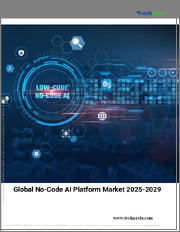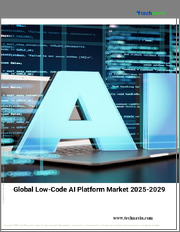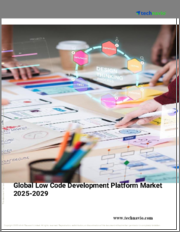
|
시장보고서
상품코드
1474884
노코드 AI 플랫폼 시장 규모, 점유율, 동향 분석 리포트 : 컴포넌트별, 기술별, 도입별, 기업 규모별, 업종별, 지역별, 부문별 예측(2024-2030년)No-code AI Platform Market Size, Share & Trends Analysis Report By Component, By Technology (NLP, Computer Vision, Predictive Analytics, Others), By Deployment, By Enterprise Size, By Vertical, By Region, And Segment Forecasts, 2024 - 2030 |
||||||
노코드 AI 플랫폼 시장의 성장과 동향 :
Grand View Research, Inc의 최신 리포트에 따르면 세계의 노코드 AI 플랫폼 시장 규모는 2030년까지 244억 2,000만 달러에 달할 것으로 예측되며, 2024-2030년의 CAGR은 30.6%로 성장할 것으로 예측되고 있습니다.
노코드 AI는 AI의 민주화를 지향하는 AI 랜드스케이프의 한 범주입니다. 머신러닝과 AI 모델을 구현하기 위해 코드가 없고, 시각적이며, 드래그 앤 드롭 방식의 인터페이스를 갖춘 노코드 AI 개발 플랫폼을 사용합니다. 노코드 AI 기능은 자동화 솔루션, 노코드 사용자 인터페이스에 통합 AI 기능을 통합한 전용 노코드 AI 툴 등 다양한 툴을 통해 제공됩니다. 노코드 AI 플랫폼은 비전문가도 쉽게 정확한 모델을 만들어 데이터를 빠르게 분석, 분류, 예측할 수 있도록 도와줍니다.
전 세계 기업은 더 나은 고객 인사이트와 직원 생산성 향상을 통해 경쟁 우위를 확보하기 위해 AI/ML 시스템에 대한 투자를 늘리도록 설득당하고 있습니다. 노코드 AI 플랫폼은 숙련된 인력 없이도 AI 모델을 생성할 수 있게 해줍니다. AI 모델 구축에는 시간, 노력, 경험이 필요한데, 데이터 과학 기술이 부족하기 때문에 이는 기업에게 큰 이점이 될 수 있습니다. 노코드 AI는 AI 모델 구축에 소요되는 시간을 몇 분으로 단축하고, 기업은 이러한 모델을 즉시 업무에 도입할 수 있습니다. 예를 들어 2023년 5월 AI 기반 카피라이팅 툴을 개발하는 라이테소닉(Writesonic)은 혁신적인 노코드 AI 챗봇 빌더인 봇소닉(Botsonic)을 출시했습니다. 이 새로운 노코드 AI 챗봇 빌더는 GPT-4 기술을 탑재하여 노코드 통합 전략을 가진 기업이라면 몇 분 만에 Botsonic을 웹사이트에 쉽게 통합할 수 있습니다.
또한 맞춤형 AI 솔루션을 구축하기 위해서는 데이터 정리, 데이터 클렌징, 코드 개발, 디버깅, 분류, 모델 트레이닝이 필요합니다. 데이터 사이언스에 익숙하지 않은 사용자에게는 상당한 시간이 소요됩니다. 노코드 AI 플랫폼은 개발 시간을 단축할 수 있는 잠재력을 가지고 있습니다. 노코드 AI 플랫폼은 각 프로세스 단계의 세부 사항을 파고들지 않고도 비전문가가 ML 모델을 구축할 수 있도록 설계되어 쉽게 사용할 수 있습니다. 또한 고품질의 저렴한 자동화 기술의 가용성이 높아짐에 따라 향후 수년간 시장 성장이 확대될 것으로 예상됩니다.
노코드 AI 플랫폼 시장 보고서 하이라이트
- 컴포넌트 기준, 노코드 AI 플랫폼 부문은 2023년 76.8%의 가장 큰 매출 점유율로 시장을 주도했습니다. 노코드 AI 플랫폼은 비전문 코더가 AI 시스템을 개발할 수 있도록 지원합니다. 사용자는 자신이 개발한 AI 시스템을 통해 데이터를 분석 및 분류하고 정확한 모델을 구축하여 예측을 할 수 있습니다.
- 기술별로는 자연어 처리 분야가 2023년 55.6%의 최대 매출 점유율로 시장을 주도했습니다. 이 기술은 기계가 인간의 언어를 인코딩하여 인간 환경을 더 깊이 이해할 수 있게 해줍니다. 사용자는 사전 훈련된 NLP 엔진을 사용하여 텍스트 기반 워크플로우를 자동화하거나 코드가 없는 NLP AI 플랫폼을 사용하여 모델을 개발할 수 있습니다.
- 배치를 기준으로 온프레미스 부문은 2023년 56.0%의 가장 큰 매출 점유율을 차지하며 시장을 주도할 것으로 예상됩니다. 온프레미스 노코드 AI 플랫폼을 통해 사용자는 풍부한 코딩 지식이나 기술 없이도 인프라 내에서 AI 용도을 구축 및 배포할 수 있습니다.
- 북미는 2023년 매출 점유율 39.5%로 시장을 장악했습니다. 이 지역에는 다양한 산업과 이용 사례에 맞는 다양한 노코드 AI 플랫폼을 제공하는 스타트업, 기존 기술 기업, 클라우드 서비스 프로바이더가 다수 존재합니다.
목차
제1장 조사 방법과 범위
제2장 주요 요약
제3장 시장의 변수, 동향, 범위
- 시장의 계보
- 업계 밸류체인 분석
- 노코드 AI 플랫폼 시장 - 시장 역학
- 시장 촉진요인 분석
- 시장 억제요인 분석
- 업계의 과제
- 비즈니스 환경 툴 분석 : 노코드 AI 플랫폼 시장
- Porter's Five Forces 분석
- PESTLE 분석
- 경제 메가트렌드 분석
제4장 노코드 AI 플랫폼 시장 : 컴포넌트 추정·동향 분석
- 노코드 AI 플랫폼 시장 : 컴포넌트별, 주요 포인트
- 노코드 AI 플랫폼 시장 : 컴포넌트 변동 분석, 2023년 및 2030년
- 노코드 AI 플랫폼
- 서비스
제5장 노코드 AI 플랫폼 시장 : 기술 추정·동향 분석
- 노코드 AI 플랫폼 시장 : 기술별, 주요 포인트
- 노코드 AI 플랫폼 시장 : 기술 변동 분석, 2023년 및 2030년
- 자연언어처리
- 컴퓨터 비전
- 예측 애널리틱스
- 기타
제6장 노코드 AI 플랫폼 시장 : 도입 추정·동향 분석
- 노코드 AI 플랫폼 시장 : 도입별, 주요 포인트
- 노코드 AI 플랫폼 시장 : 도입 변동 분석, 2023년 및 2030년
- 클라우드
- 온프레미스
제7장 노코드 AI 플랫폼 시장 : 기업 규모 추정·동향 분석
- 노코드 AI 플랫폼 시장 : 기업 규모별, 주요 포인트
- 노코드 AI 플랫폼 시장 : 기업 규모 변동 분석, 2023년 및 2030년
- 중소기업
- 대기업
제8장 노코드 AI 플랫폼 시장 : 업종 추정·동향 분석
- 노코드 AI 플랫폼 시장 : 업종별, 주요 포인트
- 노코드 AI 플랫폼 시장 : 업종 변동 분석, 2023년 및 2030년
- BFSI
- 헬스케어
- 소매·E-Commerce
- IT·통신
- 에너지·유틸리티
- 정부·공공 부문
- 기타
제9장 노코드 AI 플랫폼 시장 : 지역 추정·동향 분석
- 노코드 AI 플랫폼 시장 : 지역 변동 분석, 2023년 및 2030년
- 북미
- 미국
- 캐나다
- 유럽
- 독일
- 영국
- 프랑스
- 아시아태평양
- 중국
- 일본
- 인도
- 한국
- 호주
- 라틴아메리카
- 브라질
- 멕시코
- 중동 및 아프리카
- 사우디아라비아 왕국(KSA)
- 아랍에미리트
- 남아프리카공화국
제10장 경쟁 구도
- 기업 분류
- 기업의 시장 포지셔닝
- 기업 히트맵 분석
- 전략 매핑
- 기업 개요/상장기업
- AKKIO INC.
- Amazon.com, INC.
- Apple INC.
- Caspio, INC.
- ClarifAI, INC.
- Datarobot, INC.
- Google LLC
- LEVITY AI GMBH
- Microsoft
- Quickbase, INC.
No-code AI Platform Market Growth & Trends:
The global no-code AI platform market size is anticipated to reach USD 24.42 billion by 2030 and is projected to grow at a CAGR of 30.6% from 2024 to 2030, according to a new report by Grand View Research, Inc. The no-code AI is an AI landscape category that intends to democratize AI. It uses a no-code AI development platform with a code-free, visual, and drag-and-drop interface to implement machine learning and AI models. No-code AI capabilities are provided by various tools, including some automation solutions and dedicated no-code AI tools that incorporate integrated AI capabilities in a no-code user interface. No code AI platform allows non-technical users to quickly analyze, classify data and easily create precise models to make predictions.
Enterprises globally are persuaded to increase their investment in AI/ML systems to achieve a competitive edge through better customer insights and increased employee productivity. No-code AI platform enables the creation of AI models without requiring skilled personnel. This benefits businesses since there are simply not enough data science skills. Building AI models takes time, effort, and experience. No-code AI decreases the time it takes to construct AI models to minutes, allowing organizations to incorporate these models into their operations immediately. For instance, in May 2023, Writesonic, Inc., developer of an AI-powered copywriting tool, announced the release of Botsonic, an innovative no-code AI chatbot builder. The new no-code AI chatbot builder is equipped with GPT-4 technology, enabling any enterprise with a no-code integration strategy to effortlessly incorporate Botsonic into its website in minutes.
Moreover, building custom AI solutions necessitates data organizing, data cleansing, code development, debugging, categorizing, and model training. These take significantly longer for users who are unfamiliar with data science. No-code AI platforms have the potential to save development time. No-code AI platforms are designed to aid non-technical users in constructing ML models without delving into the specifics of each process stage, making them simple to use. Additionally, increasing high-quality, affordable automated technology availability is expected to drive market growth expansion in the coming years.
No-code AI Platform Market Report Highlights:
- Based on component, the no-code AI platforms segment led the market with the largest revenue share of 76.8% in 2023. No-code AI platform enables non-expert coders to develop AI systems. Users can use the self-developed AI system to analyze and classify data to build accurate models and make predictions
- Based on technology, the natural language processing segment led the market with the largest revenue share of 55.6% in 2023. It allows machines to encode human language, allowing them to gain a greater understanding of the human environment. Users can use pre-trained NLP engines to automate text-based workflows or a no-code NLP AI platform to develop models
- Based on deployment, the on-premises segment held the market with the largest revenue share of 56.0% in 2023. On-premise no-code AI platform allows users to build and deploy AI applications within their infrastructure without requiring extensive coding knowledge or skills
- North America dominated the market with a revenue share of 39.5% in 2023. The region is home to numerous startups, established technology companies, and cloud service providers offering a range of no-code AI platforms to cater to different industries and use cases
Table of Contents
Chapter 1. Methodology and Scope
- 1.1. Research Methodology
- 1.2. Research Scope and Assumptions
- 1.3. Information Procurement
- 1.3.1. Purchased database
- 1.3.2. GVR's internal database
- 1.3.3. Secondary sources & third-party perspectives
- 1.3.4. Primary research
- 1.4. Information Analysis
- 1.4.1. Data analysis models
- 1.5. Market Formulation & Data Visualization
- 1.6. Data Validation & Publishing
Chapter 2. Executive Summary
- 2.1. Market Outlook
- 2.2. Segmental Outlook
- 2.3. Competitive Insights
Chapter 3. Market Variables, Trends, and Scope
- 3.1. Market Lineage
- 3.2. Industry Value Chain Analysis
- 3.3. No-code AI platform Market - Market Dynamics
- 3.3.1. Market driver analysis
- 3.3.1.1. The increasing demand for AI and ML applications
- 3.3.1.2. The increasing adoption of IoT, Edge computing, and data science solutions & services across various industries.
- 3.3.2. Market restraint analysis
- 3.3.2.1. Limited customization and complexity
- 3.3.3. Industry challenges
- 3.3.1. Market driver analysis
- 3.4. Business Environmental Tools Analysis: No-code AI Platform Market
- 3.4.1. Porter's five forces analysis
- 3.4.1.1. Bargaining Power of Suppliers
- 3.4.1.2. Bargaining Power of Buyers
- 3.4.1.3. Threat of Substitution
- 3.4.1.4. Threat of New Entrants
- 3.4.1.5. Competitive Rivalry
- 3.4.2. Pestle analysis
- 3.4.2.1. Political Landscape
- 3.4.2.2. Economic Landscape
- 3.4.2.3. Social Landscape
- 3.4.2.4. Technology Landscape
- 3.4.2.5. Environmental Landscape
- 3.4.2.6. Legal Landscape
- 3.4.1. Porter's five forces analysis
- 3.5. Economic Mega Trend Analysis
Chapter 4. No-code AI Platform Market: Component Estimates & Trend Analysis
- 4.1. No-code AI Platform Market, by Component: Key Takeaways
- 4.2. No-code AI Platform Market: Component Movement Analysis, 2023 & 2030
- 4.3. No-code AI Platforms
- 4.3.1. Market estimates and forecasts, 2017 - 2030 (USD Million)
- 4.4. Services
- 4.4.1. Market estimates and forecasts, 2017 - 2030 (USD Million)
Chapter 5. No-code AI Platform Market: Technology Estimates & Trend Analysis
- 5.1. No-code AI Platform Market, by Technology: Key Takeaways
- 5.2. No-code AI Platform Market: Technology Movement Analysis, 2023 & 2030
- 5.3. Natural Language Processing
- 5.3.1. Market estimates and forecasts, 2017 - 2030 (USD Million)
- 5.4. Computer Vision
- 5.4.1. Market estimates and forecasts, 2017 - 2030 (USD Million)
- 5.5. Predictive Analytics
- 5.5.1. Market estimates and forecasts, 2017 - 2030 (USD Million)
- 5.6. Others
- 5.6.1. Market estimates and forecasts, 2017 - 2030 (USD Million)
Chapter 6. No-code AI Platform Market: Deployment Estimates & Trend Analysis
- 6.1. No-code AI Platform Market, by Deployment: Key Takeaways
- 6.2. No-code AI Platform Market: Deployment Movement Analysis, 2023 & 2030
- 6.3. Cloud
- 6.3.1. Market estimates and forecasts, 2017 - 2030 (USD Million)
- 6.4. On-premise
- 6.4.1. Market estimates and forecasts, 2017 - 2030 (USD Million)
Chapter 7. No-code AI Platform Market: Enterprise Size Estimates & Trend Analysis
- 7.1. No-code AI Platform Market, by Enterprise Size: Key Takeaways
- 7.2. No-code AI Platform Market: Enterprise Size Movement Analysis, 2023 & 2030
- 7.3. SMEs
- 7.3.1. Market estimates and forecasts, 2017 - 2030 (USD Million)
- 7.4. Large Enterprises
- 7.4.1. Market estimates and forecasts, 2017 - 2030 (USD Million)
Chapter 8. No-code AI Platform Market: Vertical Estimates & Trend Analysis
- 8.1. No-code AI Platform Market, by Vertical: Key Takeaways
- 8.2. No-code AI Platform Market: Vertical Movement Analysis, 2023 & 2030
- 8.3. BFSI
- 8.3.1. Market estimates and forecasts, 2017 - 2030 (USD Million)
- 8.4. Healthcare
- 8.4.1. Market estimates and forecasts, 2017 - 2030 (USD Million)
- 8.5. Retail & E-Commerce
- 8.5.1. Market estimates and forecasts, 2017 - 2030 (USD Million)
- 8.6. IT & Telecom
- 8.8.1. Market estimates and forecasts, 2017 - 2030 (USD Million)
- 8.7. Energy & Utilities
- 8.7.1. Market estimates and forecasts, 2017 - 2030 (USD Million)
- 8.8. Government & Public Sector
- 8.12.1. Market estimates and forecasts, 2017 - 2030 (USD Million)
- 8.9. Others
- 8.16.1. Market estimates and forecasts, 2017 - 2030 (USD Million)
Chapter 9. No-code AI Platform Market: Regional Estimates & Trend Analysis
- 9.1. No-code AI Platform Market: Regional Movement Analysis, 2023 & 2030
- 9.2. North America
- 9.2.1. Market estimates and forecasts, 2017 - 2030 (USD Million)
- 9.2.2. U.S.
- 9.2.2.1. Market estimates and forecasts, 2017 - 2030 (USD Million)
- 9.2.3. Canada
- 9.2.3.1. Market estimates and forecasts, 2017 - 2030 (USD Million)
- 9.3. Europe
- 9.3.1. Market estimates and forecasts, 2017 - 2030 (USD Million)
- 9.3.2. Germany
- 9.3.2.1. Market estimates and forecasts, 2017 - 2030 (USD Million)
- 9.3.3. U.K.
- 9.3.3.1. Market estimates and forecasts, 2017 - 2030 (USD Million)
- 9.3.4. France
- 9.3.4.1. Market estimates and forecasts, 2017 - 2030 (USD Million)
- 9.4. Asia Pacific
- 9.4.1. Market estimates and forecasts, 2017 - 2030 (USD Million)
- 9.4.2. China
- 9.4.2.1. Market estimates and forecasts, 2017 - 2030 (USD Million)
- 9.4.3. Japan
- 9.4.3.1. Market estimates and forecasts, 2017 - 2030 (USD Million)
- 9.4.4. India
- 9.4.4.1. Market estimates and forecasts, 2017 - 2030 (USD Million)
- 9.4.5. South Korea
- 9.4.5.1. Market estimates and forecasts, 2017 - 2030 (USD Million)
- 9.4.6. Australia
- 9.4.6.1. Market estimates and forecasts, 2017 - 2030 (USD Million)
- 9.5. Latin America
- 9.5.1. Market estimates and forecasts, 2017 - 2030 (USD Million)
- 9.5.2. Brazil
- 9.5.2.1. Market estimates and forecasts, 2017 - 2030 (USD Million)
- 9.5.3. Mexico
- 9.5.3.1. Market estimates and forecasts, 2017 - 2030 (USD Million)
- 9.6. Middle East & Africa
- 9.6.1. Market estimates and forecasts, 2017 - 2030 (USD Million)
- 9.6.2. Kingdom of Saudi Arabia (KSA)
- 9.6.2.1. Market estimates and forecasts, 2017 - 2030 (USD Million)
- 9.6.3. UAE
- 9.6.3.1. Market estimates and forecasts, 2017 - 2030 (USD Million)
- 9.6.4. South Africa
- 9.6.4.1. Market estimates and forecasts, 2017 - 2030 (USD Million)
Chapter 10. Competitive Landscape
- 10.1. Company Categorization
- 10.2. Company Market Positioning
- 10.3. Company Heat Map Analysis
- 10.4. Strategy Mapping
- 10.5. Company Profiles/Listing
- 10.5.1. AKKIO INC.
- 10.5.1.1. Overview
- 10.5.1.2. Financial Performance
- 10.5.1.3. Product Benchmarking
- 10.5.1.4. Strategic Initiatives
- 10.5.2. Amazon.com, INC.
- 10.5.2.1. Overview
- 10.5.2.2. Financial Performance
- 10.5.2.3. Product Benchmarking
- 10.5.2.4. Strategic Initiatives
- 10.5.3. Apple INC.
- 10.5.3.1. Overview
- 10.5.3.2. Financial Performance
- 10.5.3.3. Product Benchmarking
- 10.5.3.4. Strategic Initiatives
- 10.5.4. Caspio, INC.
- 10.5.4.1. Overview
- 10.5.4.2. Financial Performance
- 10.5.4.3. Product Benchmarking
- 10.5.4.4. Strategic Initiatives
- 10.5.5. ClarifAI, INC.
- 10.5.5.1. Overview
- 10.5.5.2. Financial Performance
- 10.5.5.3. Product Benchmarking
- 10.5.5.4. Strategic Initiatives
- 10.5.6. Datarobot, INC.
- 10.5.6.1. Overview
- 10.5.6.2. Financial Performance
- 10.5.6.3. Product Benchmarking
- 10.5.6.4. Strategic Initiatives
- 10.5.7. Google LLC
- 10.5.7.1. Overview
- 10.5.7.2. Financial Performance
- 10.5.7.3. Product Benchmarking
- 10.5.7.4. Strategic Initiatives
- 10.5.8. LEVITY AI GMBH
- 10.5.8.1. Overview
- 10.5.8.2. Financial Performance
- 10.5.8.3. Product Benchmarking
- 10.5.8.4. Strategic Initiatives
- 10.5.9. Microsoft
- 10.5.9.1. Overview
- 10.5.9.2. Financial Performance
- 10.5.9.3. Product Benchmarking
- 10.5.9.4. Strategic Initiatives
- 10.5.10. Quickbase, INC.
- 10.5.10.1. Overview
- 10.5.10.2. Financial Performance
- 10.5.10.3. Product Benchmarking
- 10.5.10.4. Strategic Initiatives
- 10.5.1. AKKIO INC.
(주말 및 공휴일 제외)


















